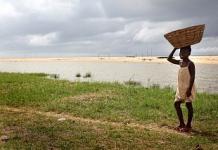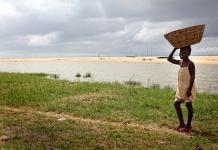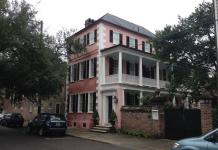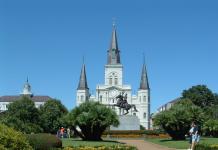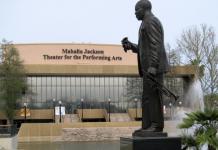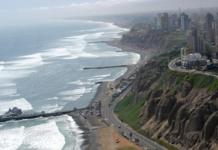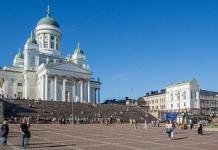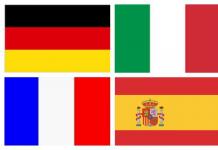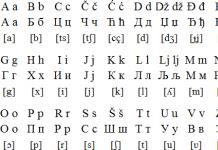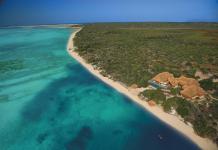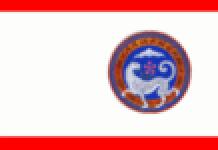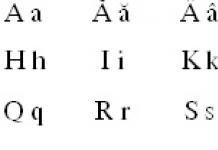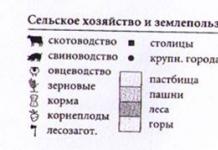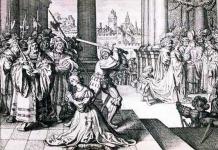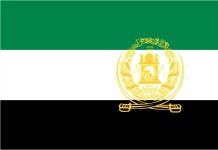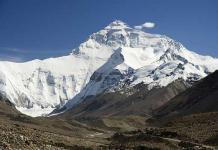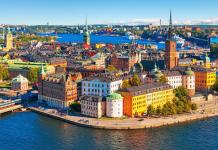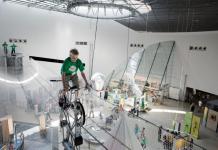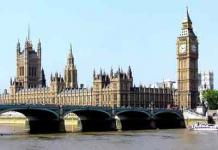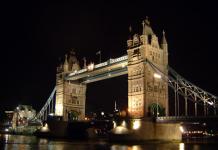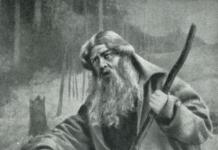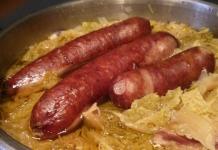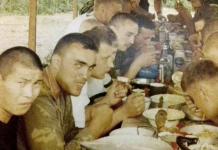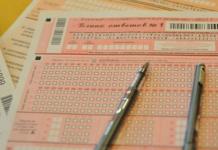Finding a sea route to India was a very important task for Portugal. A country located away from the main trade routes of that time could not fully participate in world trade. Exports were small, and the valuable goods of the East had to be bought by the Portuguese at very high prices. At the same time, the geographical position of Portugal was very conducive to discoveries on the western coast of Africa and attempts to find a sea route to the “land of spices”.
In 1488, Bartolomeu Dias discovered the Cape of Good Hope, circled Africa and entered the Indian Ocean. After that, he had to turn back, as the sailors demanded a return to Portugal. Based on the discoveries of Dias, King João II was about to send a new expedition. However, preparations for it dragged on and got off the ground only after the accession to the throne of Manuel I in 1495.
The head of the new expedition was not Bartolomeu Dias, but Vasco da Gama, who at that time was 28 years old. He was born in the Portuguese seaside town of Sines and belonged to an old aristocratic family. He had at his disposal two heavy ships, the San Gabriel and the San Rafael, a light fast ship, the Berriu, and a transport ship with supplies. The crew of all ships reached 140-170 people.

2 Swimming
The ships passed by the Canary Islands, separated in the fog and gathered at the Cape Verde Islands. The journey was hampered by headwinds. Vasco da Gama turned to the southwest and, a little before reaching Brazil, thanks to a fair wind, managed to reach the Cape of Good Hope in the most convenient way. On November 22, the flotilla rounded the cape and entered unfamiliar waters.

At Christmas, the ships entered the bay, which was called the Harbor of Christmas (port of Natal). At the end of January 1498, the expedition reached the mouth of the Zambezi River, where it stayed for about a month, repairing ships.
Moving further along the east coast of Africa, the Portuguese reached Mozambique on 2 March. Here began the territories controlled by the Arabs. Vasco da Gama had enough interpreters, so that the further navigation took place along a route that was quite understandable for the Portuguese: they knew the distances, the main ports where they had to stop.
3 India
In a wealthy Somali city, Melinda Gama managed to negotiate with the sheikh, and he provided him with a pilot. With his help, the expedition reached India in May 1498. The ships stopped at the city of Calicut (Kozhikode). The local ruler - zamorin - cordially received the ambassador of the Portuguese captain. However, Gama sent gifts to the ruler that had no value, relations between him and the ruler cooled, and the situation in the city, on the contrary, escalated to the limit. Muslim merchants turned the townspeople against the Portuguese. The ruler did not give Vasco da Gama permission to establish a trading post.

On August 9, before leaving, da Gama turned to the Zamorin with a letter, in which he recalled the promise to send an embassy to Portugal and asked him to send several bags of spices as a gift to the king. However, the ruler of Calicut in response demanded payment of customs duties. He ordered the arrest of several Portuguese, accusing them of espionage. In turn, Vasco da Gama took hostage several noble Calicutians who visited the courts. When the Zamorin returned the Portuguese and part of the goods, Vasco da Gama sent half of the hostages ashore, and took the rest with him. On August 30, the squadron set off on its return journey.
The way back was not easy. On January 2, 1499, the sailors of da Gama saw the Somali port of Mogadishu. In September 1499, Vasco da Gama returned to his homeland a hero, although he lost two ships and two-thirds of the crew, including his beloved brother Paulo.
4 Second voyage to India. departure
Immediately after the opening of the sea route to India, the Portuguese kingdom began to organize annual expeditions there. An expedition in 1500, led by Pedro Alvares Cabral, concluded a trade agreement with the Zamorin of Calicut and established a trading post there. But the Portuguese came into conflict with the Arab merchants of Calicut, the trading post was burned, and Cabral sailed out of the city, firing at him with cannons.

Vasco da Gama was again appointed head of a new large expedition, equipped after the return of Cabral. Part of the flotilla (15 ships out of 20) left Portugal in February 1502.
5 Swimming
Beyond the equator, probably for the purpose of reconnaissance, Gama went, not moving far from land, along the coasts of Arabia and North-West India to the Gulf of Cambay, and from there turned south.

At Kannanur, Gama's ships attacked an Arab ship sailing from Jeddah (the harbor of Mecca) to Calicut with valuable cargo and 400 passengers, mostly pilgrims. Having plundered the ship, Gama ordered the sailors to lock the crew and passengers in the hold, among whom were many old men, women and children, and the bombardiers to set fire to the ship.
6 India
Having made an alliance with the ruler of Kannanur, Gama moved a flotilla against Calicut at the end of October. He began by hanging 38 fishermen on yardarms, who offered fish to the Portuguese, and bombarded the city. At night, he ordered to remove the corpses, cut off the heads, arms and legs, dump the bodies into the boat. Gama attached a letter to the boat saying that this would be the fate of all citizens if they resisted. The tide washed the boat and the stumps of the corpses ashore. The next day, Gama again bombarded the city, plundered and burned a cargo ship approaching it. Leaving seven ships to blockade Calicut, he sent two other ships to Kannanur for spices, and with the rest went for the same cargo to Cochin.
After two "victorious" skirmishes near Calicut with Arab ships, Vasco da Gama in February 1503 led the ships back to Portugal, where he arrived in October with a cargo of spices of great value. After this success, Gama's pension and other incomes were significantly increased, and later he received the title of count.
7 Third voyage
In 1505, King Manuel I, on the advice of Vasco da Gama, established the position of Viceroy of India. Successive Francisco d'Almeida and Affonso d'Albuquerque strengthened Portugal's power on Indian soil and in the Indian Ocean with cruel measures. However, after the death of Albuquerque in 1515, his successors began to cope with their tasks much worse, thinking more about personal enrichment.
The king of Portugal, João III, decided to appoint the 54-year-old harsh and incorruptible Vasco da Gama as the second viceroy. In April 1524, the admiral sailed from Portugal. Vasco da Gama was accompanied by two sons - Estevan da Gama and Paulo da Gama.
8 India. Death
Immediately upon his arrival in India, da Gama took firm action against the abuses of the colonial administration. But on December 24, 1524, Vasco da Gama died of malaria in Cochin.
What contribution did Vasco da Gama make to geography, you will learn from this article.
He is a famous Portuguese navigator of the era of the Great Geographical Discoveries. He combined the office of governor with the viceroy of Portuguese India. Vasco da Gama discovered the sea route to India with an expedition of 1497-1499 around Africa.
Significance of the discovery of Vasco da Gama
He prepared his voyage very carefully. The country that equipped Vasco da Gama is Portugal, and the Portuguese king himself appointed him the commander of the expedition, preferring him instead of the experienced and famous Dias. And the life of Vasco da Gama revolved around this event. The expedition will send three warships and one transport.
The navigator solemnly sailed from Lisbon on July 8, 1497. The first months were quite calm. In November 1497 he reached the Cape of Good Hope. Strong storms began, and his team demanded to take the way back, but Vasco da Gama threw all navigation instruments and quadrants overboard, showing that there was no way back. And he was right, because he managed to find a direct sea route to India. Vasco da Gama's contribution to geography lies in the fact that he charted a route to the land of spices, safer and shorter than it had previously been by land.
The results of the Vasco da Gama expedition: the opening of a new route to India significantly expanded trade opportunities with Asia, which had previously been carried out exclusively along the Great Silk Road. Although this discovery was quite expensive - 2 out of 4 ships returned from the trip.
PAfter the discovery of the “Western India” by the Spanish expeditions of Columbus, the Portuguese had to hurry in order to secure their “rights” to the East Indies. In 1497, a squadron was equipped to explore the sea route from Portugal - around Africa - to India. Suspicious Portuguese kings were wary of famous navigators. Therefore, the head of the new expedition was not Bartolomeu Dias, and a young courtier of noble origin who had not shown himself in anything before Vasco (Basco) da Gama, who, for unknown reasons, was chosen by the king Manuela I. At the disposal of Gama, he provided three ships: two heavy ships, 100–120 tons (i.e., 200–240 metric tons) each, the San Gabriel, on which Vasco raised the admiral's flag (captain Goncalo Alvaris, an experienced sailor), and "San Rafael", whose captain was appointed at the request of Vasco, his older brother Paulo da Gama, which also did not show itself in any way, and a light high-speed vessel "Berriu" of 50 tons (captain Nicolau Cuelho). In addition, a supply ship accompanied the flotilla. The chief navigator was an outstanding sailor Peru Alenquer, who previously sailed in the same position with B. Dias. The crew of all ships reached 140-170 people, this included 10-12 criminals: Gama begged them from the king to use them for dangerous assignments.
On July 8, 1497, the flotilla left Lisbon and probably passed as far as Sierra Leone. From there, Gama, on the advice of experienced sailors, in order to avoid contrary winds and currents off the coast of Equatorial and South Africa, moved southwest, and turned southeast beyond the equator. There is no more accurate data on the path of Gama in the Atlantic, and the assumption that he approached the coast of Brazil is based on the routes of later navigators, starting from Cabral. After almost four months of navigation, on November 1, the Portuguese saw land in the east, and three days later they entered a wide bay, which was given the name of St. Helena (St. Helena, 32 ° 40 "S), and opened the mouth of the Santiago River ( now Great Berg). Having landed on the shore, they saw two almost naked short men (Bushmen) with skin “the color of dry leaves”, smoking from the nests of wild bees. They managed to capture one. Gama ordered to feed and clothe him, gave him several strings of beads and bells and let go. The next day, a dozen and a half Bushmen came, with whom Gama did the same, two days later - about fifty. For trinkets they gave everything they had, but these things were of no value in the eyes of the Portuguese. When but the Bushmen were shown gold, pearls and spices, they did not show any interest in them and it was not evident from their gestures that they had such things. This "idyll" ended in a skirmish due to the fault of a sailor who somehow offended the Bushmen. Three or four Portuguese was and wounded by stones and arrows. Gama also used crossbows against the "enemies". It is not known how many natives were killed and wounded in the process. Rounding the southern tip of Africa, the Portuguese anchored in that "Harbor of the Shepherds" where Bartolomeu Dias killed the Hottentot. This time, the sailors behaved peacefully, opened a "silent bargain" and received a bull and ivory bracelets from the shepherds for red caps and bells.
By the end of December 1497, on the religious holiday of Christmas, the Portuguese ships sailing to the northeast were at approximately 31 ° S. sh. against the high bank, which Gama called Natal ("Christmas"). On January 11, 1498, the flotilla stopped at the mouth of a river. When the sailors landed, they were approached by a crowd of people, very different from those they met on the coast of Africa. The sailor, who used to live in the country of the Congo and spoke the local language of the Bantu, delivered a speech to those who came up, and they understood him (all the languages of the Bantu family are similar). The country was densely populated by farmers who processed iron and non-ferrous metals: sailors saw iron tips on arrows and spears, daggers, copper bracelets and other jewelry. They met the Portuguese very friendly, and Gama called this land "the country of good people."
Moving north, on January 25, the vessels entered the estuary at 18 ° S. sh., where several rivers flowed. Residents here also received strangers well. Two chiefs appeared on the shore, wearing silk headdresses. They imposed printed fabrics with patterns on the sailors, and the African accompanying them said that he was an alien and had already seen ships that looked like Portuguese ones. His story and the presence of goods, undoubtedly of Asian origin, convinced Gama that he was approaching India. He called the estuary "a river of good omens" and placed a padran on the bank - a stone heraldic pillar with inscriptions, which had been erected since the 80s. 15th century by the Portuguese on the African coast at the most important points. From the west, the Kwakwa, the northern branch of the Zambezi delta, flows into the estuary. In this regard, it is usually not entirely correct to say that Gama discovered the mouth of the Zambezi, and they transfer the name that he gave to the estuary to the lower reaches of the river. For a month, the Portuguese stood at the mouth of the Kwakva, repairing ships. They suffered from scurvy, and the mortality rate was high. On February 24, the flotilla left the estuary. Keeping away from the coast, bordered by a chain of islets, and stopping at night so as not to run aground, five days later she reached 15 ° S. sh. port of Mozambique. Arab one-masted ships (dhows) visited the port annually and exported mainly slaves, gold, ivory and ambergris. Through the local sheikh (ruler), Gama hired two pilots in Mozambique. But Arab merchants guessed dangerous competitors in the newcomers, and friendly relations soon turned into hostile ones. Water, for example, could be taken only after the “enemy” was scattered with cannon shots, and when some of the inhabitants fled, the Portuguese captured several boats with their property and, by order of Gama, divided it among themselves as war booty.
|
Path of Vasco da Gamma, 1497-1499 |
On April 1, the flotilla left Mozambique to the north. Not trusting the Arab pilots, Gama seized a small sailing ship off the coast and tortured the old man, his owner, in order to get the information needed for further navigation. A week later, the flotilla approached the port city of Mombasa (4 ° S), where then the powerful sheikh ruled. A major slave trader himself, he probably sensed rivals in the Portuguese, but at first he received the foreigners well. The next day, as the ships entered the harbor, the Arabs on board, including both pilots, jumped into a nearby dhow and fled. At night, Gama ordered the torture of two captives captured from Mozambique in order to find out from them about the "conspiracy in Mombasa." They tied their hands and poured a boiling mixture of oil and tar over their naked bodies. The unfortunate, of course, confessed to the "conspiracy", but, since they, of course, could not provide any details, the torture continued. One prisoner with his hands tied escaped from the hands of the executioners, threw himself into the water and drowned. Leaving Mombasa, Gama detained an Arab dhow at sea, plundered it and captured 19 people. On 14 April she anchored in Malindi Harbor (3° S).
Ahmed Ibn Majid and the Arabian Sea
Mthe local sheikh greeted Gama in a friendly way, as he himself was at enmity with Mombasa. He made an alliance with the Portuguese against a common enemy and gave them a reliable old pilot, Ahmed Ibn Majid, who was to lead them to Southwestern India. With him, the Portuguese left Malindi on April 24. Ibn Majid took a course to the northeast and, taking advantage of the favorable monsoon, brought the ships to India, the coast of which appeared on May 17th.
Seeing Indian land, Ibn Majid moved away from the dangerous coast and turned south. Three days later, a high cape appeared, probably Mount Delhi (at 12 ° N). Then the pilot approached the admiral with the words: "Here is the country to which you aspired." By the evening of May 20, 1498, the Portuguese ships, having advanced about 100 km to the south, stopped on the roadstead against the city of Calicut (now Kozhikode).
At the same time the flotilla was visited by the officials of the Samorin, the local ruler. Gama sent a criminal with them to the shore, who knew a little Arabic. According to the messenger, he was taken to two Arabs, who spoke to him in Italian and Castilian. The first question he was asked was, "Which devil brought you here?" The messenger replied that the Portuguese had come to Calicut "to look for Christians and spices." One of the Arabs escorted the envoy back, congratulated Gama on his arrival and ended with the words: "Thank God that he brought you to such a rich country." The Arab offered his services to Gama and was indeed very useful to him. The Arabs, very numerous in Calicut (almost all foreign trade with South India was in their hands), turned the Samorin against the Portuguese; besides, in Lisbon they did not guess to supply Gama with valuable gifts or gold to bribe the local authorities. After Gama personally delivered letters from the king to Samorin, he and his retinue were detained. They were released only a day later, when the Portuguese unloaded some of their goods ashore. However, in the future, Samorin was quite neutral and did not interfere with trade, but the Muslims did not buy Portuguese goods, pointing to their poor quality, and the poor Indians paid much less than the Portuguese expected to receive. Still managed to buy or receive in exchange cloves, cinnamon and precious stones - a little bit of everything.
So more than two months passed. On August 9, Gama sent gifts to Samorin (amber, corals, etc.) and said that he was going to leave and asked to send a representative with him with gifts to the king - with bahar (more than two centners) of cinnamon, bahar of cloves and samples of other spices. Samorin demanded that 600 sheraffins (about 1,800 gold rubles) be paid customs duties, but for now he gave the order to detain goods in a warehouse and forbade residents to transport the Portuguese remaining on the shore to ships. However, Indian boats, as before, approached the ships, curious townspeople examined them, and Gama very kindly received guests. One day, having learned that there were noble people among the visitors, he arrested several people and informed the Samorin that he would release them when the Portuguese who remained on the shore and the detained goods were sent to the ships. A week later, after Gama threatened to execute the hostages, the Portuguese were taken to the ships. Gama released some of the arrested, promising to release the rest after the return of all the goods. Zamorin agents hesitated, and on August 29, Gama left Calicut with noble hostages on board.
The Oud slowly moved north along the Indian coast due to weak variable winds. September 20, the Portuguese anchored at about. Anjidiv (14 ° 45 "N), where they repaired their ships. During the repair, pirates approached the island, but Gama put them to flight with cannon shots. Leaving Anjidiv in early October, the flotilla tacked or stood motionless for almost three months, until a favorable wind finally blew in. In January 1499, the Portuguese reached Malindi. The sheikh supplied the flotilla with fresh supplies, at the insistence of Gama sent a gift to the king (an elephant tusk) and set up a padran. In the area of Mombasa, Gama burned the San Rafael ": A greatly reduced team, in which many people were sick, was unable to manage three ships. On February 1, he reached Mozambique. It then took seven weeks to go to the Cape of Good Hope and four more to the Cape Verde Islands. Here" San Gabriel parted ways with the Berriu, which, under the command of N. Cuelho, was the first to arrive in Lisbon on July 10, 1499.

Vasca da Gamma
Paulo da Gama was terminally ill. Vasco, very attached to him (the only human trait of his character), wanted his brother to die in his native land. He passed from Fr. Santiago from the San Gabriel to a fast caravel hired by him and went to the Azores, where Paulo died. After burying him, Vasco arrived in Lisbon by the end of August. Of his four ships, only two returned, It is not known where and under what conditions the transport ship was abandoned or perished, and the fate of its crew has not been clarified. from the team - less than half (according to one version - 55 people) and among them a sailor Joao da Lizboa who took part in the voyage, probably as a navigator. Later, he repeatedly drove Portuguese ships to India and compiled a description of the route, including a description of the coast of Africa - not only large bays and bays, but estuaries, capes, and even individual notable points on the coast. This work was surpassed in detail only in the middle of the 19th century. "African pilot" of the British Admiralty.
Gama's expedition was not unprofitable for the crown, despite the loss of two ships: in Calicut, they managed to acquire spices and jewelry in exchange for government goods and personal belongings of sailors, Gama's pirate operations in the Arabian Sea brought considerable income. But, of course, this is not what caused the jubilation in Lisbon among the ruling circles. The expedition found out what enormous benefits direct maritime trade with India could bring for them with the proper economic, political and military organization of the business. The opening of the sea route to India for Europeans was one of the greatest events in the history of world trade. From that moment until the digging of the Suez Canal (1869), the main commerce of Europe with the countries of the Indian Ocean and with China did not go through the Mediterranean Sea, but through the Atlantic Ocean - past the Cape of Good Hope. Portugal, holding in its hands the "key to eastern navigation", became in the 16th century. the strongest maritime power, seized the monopoly of trade with South and East Asia and held it for 90 years - until the defeat of the "Invincible Armada" (1588).
Web design © Andrey Ansimov, 2008 - 2014
Equipment of the Gama expedition and passage to South Africa
After the discovery of the “Western India” by the Spanish expeditions of Columbus, the Portuguese had to hurry in order to secure their “rights” to the East Indies. In 1497, a squadron was equipped to explore the sea route from Portugal - around Africa - to India. Suspicious Portuguese kings were wary of famous navigators. Therefore, the head of the new expedition was not Bartolomeu Dias, and a young courtier of noble origin who had not shown himself in anything before Vasco (Vashku) da Gama, who, for unknown reasons, was chosen by the king Manuela I. At the disposal of Gama, he provided three ships: two heavy ships, 100-120 tons (i.e., 200-240 metric tons) each, the San Gabriel, on which Vasco raised the admiral's flag (Captain Goncalo Alvaris, an experienced sailor), and "San Rafael", whose captain was appointed at the request of Vasco, his older brother Paulo da Gama, which also did not show itself in any way, and a light high-speed vessel "Berriu" of 50 tons (captain Nicolau Cuelho). In addition, a supply ship accompanied the flotilla. The chief navigator was an outstanding sailor Peru Alenquer, who previously sailed in the same position with B. Dias. The crew of all ships reached 140-170 people, this included 10-12 criminals: Gama begged them from the king to use them for dangerous assignments.
Portrait of Vasco da Gama at the age of 64. Museum of Ancient Arts, Lisbon
On July 8, 1497, the flotilla left Lisbon and probably passed as far as Sierra Leone. From there, Gama, on the advice of experienced sailors, in order to avoid contrary winds and currents off the coast of Equatorial and South Africa, moved southwest, and turned southeast beyond the equator. There is no more accurate data on the path of Gama in the Atlantic, and the assumption that he approached the coast of Brazil is based on the routes of later navigators, starting from Cabral. After almost four months of navigation, on November 1, the Portuguese saw land in the east, and three days later they entered a wide bay, which was given the name of St. Helena (St. Helena, 32 ° 40 "S), and opened the mouth of the Santiago River ( now Great Berg). Having landed on the shore, they saw two almost naked short men (Bushmen) with skin “the color of dry leaves”, smoking from the nests of wild bees. They managed to capture one. Gama ordered to feed and clothe him, gave him several strings of beads and bells and let go. The next day, a dozen and a half Bushmen came, with whom Gama did the same, two days later - about fifty. For trinkets they gave everything they had, but these things were of no value in the eyes of the Portuguese. When but the Bushmen were shown gold, pearls and spices, they did not show any interest in them and it was not evident from their gestures that they had such things. This "idyll" ended in a skirmish due to the fault of a sailor who somehow offended the Bushmen. Three or four the Portuguese were wounded by a stone pits and arrows. Gama also used crossbows against the "enemies". It is not known how many natives were killed and wounded in the process. Rounding the southern tip of Africa, the Portuguese anchored in that "Harbor of the Shepherds" where Bartolomeu Dias killed the Hottentot. This time, the sailors behaved peacefully, opened a "silent bargain" and received a bull and ivory bracelets from the shepherds for red caps and bells.
Sailing along the coast of East Africa
By the end of December 1497, on the religious holiday of Christmas, the Portuguese ships sailing to the northeast were at approximately 31 ° S. sh. against the high bank, which Gama called Natal ("Christmas"). On January 11, 1498, the flotilla stopped at the mouth of a river. When the sailors landed, they were approached by a crowd of people, very different from those they met on the coast of Africa. A sailor who used to live in the country of the Congo and spoke the local Bantu language addressed a speech to those who came up, and they understood him (all languages of the Bantu family are similar). The country was densely populated by farmers who processed iron and non-ferrous metals: sailors saw iron tips on arrows and spears, daggers, copper bracelets and other jewelry. They met the Portuguese very friendly, and Gama called this land "the country of good people."

Ships of the Vasco da Gama squadron. Gordon Miller
Moving north, on January 25, the vessels entered the estuary at 18 ° S. sh., where several rivers flowed. Residents here also received strangers well. Two chiefs appeared on the shore, wearing silk headdresses. They imposed printed fabrics with patterns on the sailors, and the African accompanying them said that he was a stranger and had already seen ships that looked like Portuguese ones. His story and the presence of goods, undoubtedly of Asian origin, convinced Gama that he was approaching India. He called the estuary "a river of good omens" and placed a padran on the bank - a stone armorial pillar with inscriptions, which had been erected since the 80s. 15th century by the Portuguese on the African coast at the most important points. From the west, the Kwakwa, the northern branch of the Zambezi Delta, flows into the estuary. In this regard, it is usually not entirely correct to say that Gama discovered the mouth of the Zambezi, and they transfer the name that he gave to the estuary to the lower reaches of the river. For a month, the Portuguese stood at the mouth of the Kwakva, repairing ships. They suffered from scurvy, and the mortality rate was high. On February 24, the flotilla left the estuary. Keeping away from the coast, bordered by a chain of islets, and stopping at night so as not to run aground, she reached 15 ° S in five days. sh. port of Mozambique. Arab one-masted ships (dhows) visited the port annually and exported mainly slaves, gold, ivory and ambergris. Through the local sheikh (ruler), Gama hired two pilots in Mozambique. But Arab merchants guessed dangerous competitors in the newcomers, and friendly relations soon turned into hostile ones. Water, for example, could be taken only after the “enemy” was scattered with cannon shots, and when some of the inhabitants fled, the Portuguese captured several boats with their property and, by order of Gama, divided it among themselves as war booty.

Path of Vasco da Gama, 1497-1499
On April 1, the flotilla left Mozambique to the north. Not trusting the Arab pilots, Gama seized a small sailing ship off the coast and tortured the old man, his owner, in order to get the information needed for further navigation. A week later, the flotilla approached the port city of Mombasa (4 ° S), where then the powerful sheikh ruled. Himself a major slave trader, he probably felt rivals in the Portuguese, but at first he received foreigners well. The next day, as the ships entered the harbor, the Arabs on board, including both pilots, jumped into a nearby dhow and fled. At night, Gama ordered the torture of two captives captured from Mozambique in order to find out from them about the "conspiracy in Mombasa." They tied their hands and poured a boiling mixture of oil and tar over their naked bodies. The unfortunate, of course, confessed to the "conspiracy", but, since they, of course, could not provide any details, the torture continued. One prisoner with his hands tied escaped from the hands of the executioners, threw himself into the water and drowned. Leaving Mombasa, Gama detained an Arab dhow at sea, plundered it and captured 19 people. On 14 April she anchored in Malindi Harbor (3° S).
Ahmed Ibn Majid and the Arabian Sea
The local sheikh greeted Gama in a friendly way, as he himself was at enmity with Mombasa. He made an alliance with the Portuguese against a common enemy and gave them a reliable old pilot. Ahmed Ibn Majid(hereditary navigator, whose father and grandfather were muallims (Muallim - a captain who knows astronomy and is familiar with the conditions of navigation along the coast, literally a teacher, mentor)) which was supposed to bring them to Southwestern India. With him, the Portuguese left Malindi on April 24. Ibn Majid took a course to the northeast and, taking advantage of the favorable monsoon, brought the ships to India, the coast of which appeared on May 17.
Seeing Indian land, Ibn Majid moved away from the dangerous coast and turned south. Three days later, a high cape appeared, probably Mount Delhi (at 12 ° N). Then the pilot approached the admiral with the words: "Here is the country to which you aspired." By the evening of May 20, 1498, the Portuguese ships, having advanced about 100 km to the south, stopped on the roadstead against the city of Calicut (now Kozhikode).
Portuguese in Calicut
In the morning, the flotilla was visited by officials of the Samorin, the local ruler. Gama sent a criminal with them to the shore, who knew a little Arabic. According to the messenger, he was taken to two Arabs, who spoke to him in Italian and Castilian. The first question he was asked was: "Which devil brought you here?" The messenger replied that the Portuguese had come to Calicut "to look for Christians and spices." One of the Arabs escorted the envoy back, congratulated Gama on his arrival and ended with the words: "Thank God that he brought you to such a rich country." The Arab offered his services to Gama and was indeed very useful to him. The Arabs, very numerous in Calicut (almost all foreign trade with South India was in their hands), turned the Samorin against the Portuguese; besides, in Lisbon they did not guess to supply Gama with valuable gifts or gold to bribe the local authorities. After Gama personally delivered letters from the king to Samorin, he and his retinue were detained. They were released only a day later, when the Portuguese unloaded some of their goods ashore. However, in the future, Samorin was quite neutral and did not interfere with trade, but the Muslims did not buy Portuguese goods, pointing to their poor quality, and the poor Indians paid much less than the Portuguese expected to receive. Still managed to buy or receive in exchange cloves, cinnamon and precious stones - a little of everything.

Vasco da Gama brings gifts to the ruler of Calcutta.
Colored beads were brought as gifts, hats with feathers and many other similar things. The ruler did not accept the gifts, and his entourage “laughed as soon as they saw these gifts.” Paolo Novaresio, The Explorers, White Star, Italy, 2002
So more than two months passed. On August 9, Gama sent gifts to Samorin (amber, corals, etc.) and said that he was going to leave and asked to send a representative with him with gifts to the king - with bahar (more than two centners) of cinnamon, bahar of cloves and samples of other spices. Samorin demanded that 600 sheraffins (about 1,800 gold rubles) be paid customs duties, but for now he gave the order to detain goods in a warehouse and forbade residents to transport the Portuguese remaining on the shore to ships. However, Indian boats, as before, approached the ships, curious townspeople examined them, and Gama very kindly received guests. One day, having learned that there were noble people among the visitors, he arrested several people and informed the Samorin that he would release them when the Portuguese who remained on the shore and the detained goods were sent to the ships. A week later, after Gama threatened to execute the hostages, the Portuguese were taken to the ships. Gama released some of the arrested, promising to release the rest after the return of all the goods. Zamorin agents hesitated, and on August 29, Gama left Calicut with noble hostages on board.
Return to Lisbon
The ships moved slowly north along the Indian coast due to weak variable winds. September 20, the Portuguese anchored at about. Anjidiv (14 ° 45 "N. Lat.), where they repaired their ships. During the repair, pirates approached the island, but Gama put them to flight with cannon shots. Leaving Anjidiv in early October, the flotilla tacked or stood motionless for almost three months, until a favorable wind finally blew in. In January 1499, the Portuguese reached Malindi. The sheikh supplied the flotilla with fresh supplies, at the insistence of Gama sent a gift to the king (an elephant tusk) and set up a padran. In the area of Mombasa, Gama burned the San Rafael ": A greatly reduced team, in which many people were sick, was unable to manage three ships. On February 1, he reached Mozambique. It then took seven weeks to go to the Cape of Good Hope and four more to the Cape Verde Islands. Here" San Gabriel parted ways with the Berriu, which, under the command of N. Cuelho, was the first to arrive in Lisbon on July 10, 1499.

Vasca da Gama. Portrait
Paulo da Gama was terminally ill. Vasco, very attached to him (the only human trait of his character), wanted his brother to die in his native land. He passed from Fr. Santiago from the San Gabriel to a fast caravel hired by him and went to the Azores, where Paulo died. After burying him, Vasco arrived in Lisbon by the end of August. Of his four ships, only two returned ( It is not known where and under what conditions the transport ship was abandoned or died, and the fate of its crew has not been clarified) , less than half of the team (according to one version - 55 people) and among them a sailor Joao da Lizboa who took part in the voyage, probably as a navigator. Later, he repeatedly drove Portuguese ships to India and compiled a description of the route, including a description of the coast of Africa - not only large bays and bays, but estuaries, capes, and even individual noticeable points on the coast. This work was surpassed in detail only in the middle of the 19th century. "African pilot" of the British Admiralty.
Gama's expedition was not unprofitable for the crown, despite the loss of two ships: in Calicut, they managed to acquire spices and jewelry in exchange for government goods and personal belongings of sailors, Gama's pirate operations in the Arabian Sea brought considerable income. But, of course, this is not what caused the jubilation in Lisbon among the ruling circles. The expedition found out what enormous benefits direct maritime trade with India could bring for them with the proper economic, political and military organization of the business. The opening of the sea route to India for Europeans was one of the greatest events in the history of world trade. From that moment until the digging of the Suez Canal (1869), the main commerce of Europe with the countries of the Indian Ocean and with China did not go through the Mediterranean Sea, but through the Atlantic Ocean - past the Cape of Good Hope. Portugal, holding in its hands the "key to eastern navigation", became in the 16th century. the strongest maritime power, seized the monopoly of trade with South and East Asia and held it for 90 years - until the defeat of the "Invincible Armada" (1588).
What the navigator Vasco da Gama discovered and in what year, you will learn from this article.
Vasco da Gama is a famous Portuguese navigator of the Age of Discovery. He combined the office of governor with the viceroy of Portuguese India. Vasco da Gama discovered the sea route to India with an expedition of 1497-1499 around Africa.
How did Vasco da Gama discover the sea route to India?
He prepared his voyage very carefully. The Portuguese king himself appointed him the commander of the expedition, preferring him instead of the experienced and famous Dias. And the life of Vasco da Gama revolved around this event. The expedition will send three warships and one transport.
The navigator solemnly sailed from Lisbon on July 8, 1497. The first months were quite calm. In November 1497 he reached the Cape of Good Hope. Strong storms began, and his team demanded to take the way back, but Vasco da Gama threw all navigation instruments and quadrants overboard, showing that there was no way back.
Having bypassed the southern part of Africa, the expedition stopped in Mossel Bay. Many members of his crew died of scurvy, and the ship that was carrying supplies was badly damaged and had to be burned.
The great discovery of Vasco da Gama began from the moment he entered the waters of the Indian Ocean. On April 24, 1498, a course was taken to the north east. Already on May 20, 1498, the navigator moored his ships at Calicut, a small Indian town. The flotilla stayed in its port for 3 months. Trade between the team of Vasco da Gama and the Indians did not go very smoothly, and he was forced to leave the shores of the country of "oriental spices". On the way back, his team was engaged in robbery and shelling of coastal villages. On January 2, 1499, the flotilla sailed to the town of Magadisho, heading home. The first journey ended in the early autumn of 1499: only 2 ships out of 4 returned to Portugal, and 55 people out of 170 sailors.
Discovery of India Vasco da Gama covered all travel expenses. The brought spices, seasonings, fabrics and other goods were sold at a very high price, because Europe had not yet seen and did not know what was brought by the navigator. The expedition traveled 40,000 km and explored more than 4,000 km of the east coast of Africa. But the main geographical discoveries of Vasco da Gama were that he was the discoverer of the sea route to India and it was he who put it on the map. Even today, this is the most convenient way to the land of spices, passing through the Cape of Good Hope. Thanks to the navigator, Portugal received the title of the most powerful maritime power in the world.



